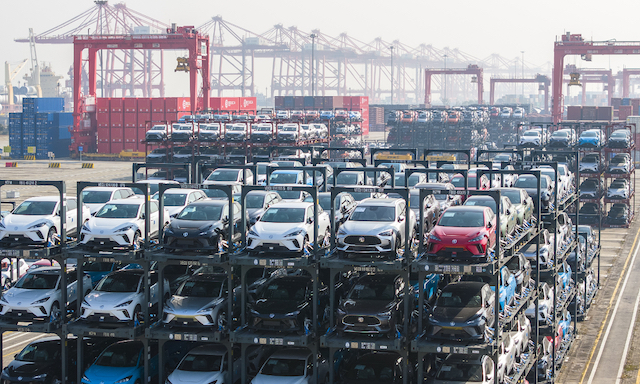
In June 2019, investment bank UBS and the research division of financial news company Bloomberg predicted electric vehicles (EVs) could reach cost parity with conventional petrol ones within five years.
Around the same time, Ford said that by 2024 all its passenger vehicles in Europe would be EVs or hybrids. It quickly added the same vehicles would all be emission-free EVs by 2030.
It’s almost halfway through 2024 and it appears UBS, Bloomberg, and Ford were clearly influenced five years ago by the fairy dust opportunists had sprinkled over EVs and zero emissions targets.
Although, of course, UBS and Bloomberg might have had China’s burgeoning car industry in mind when predicting cost parity. In China, with the state subsidising carmakers up the wazoo, a new small EV city car can be had today for as little as 49,900 yuan, or $NZ11,500.
Five years on from 2019, Ford – in this case in the UK and Europe – is reimagining its future. It is being forced to do so by two things: the UK government’s Zero-Emissions Vehicle mandate (ZEV), and imports of cheaper EVs from China.
Under ZEV laws passed in January, carmakers in the UK have to ensure that 22 per cent of the vehicles they move in 2024 through dealers are emission-free. This demand ratchets up to 80 per cent by 2030, and 100 per cent by 2035. A total ban on new petrol car sales will then follow in 2035.
If they don’t hit their quota, bigger carmakers face fines of more than $NZ30,000 per vehicle. There is some wiggle room to allow them to trade carbon credits. Smaller makers are not bound by the EV sales targets but will be forced to comply with the 2035 ban.
UK transport decarbonisation minister Anthony Browne has said he didn’t expect carmakers to end up paying the fines because the EV market in the UK was still in relative infancy, and that cheaper EV cars from Chinese brands would help stoke the market.
Private UK buyers don’t want EVs; the all-electric family car doesn’t qualify for tax credits. Fleet company EVs do qualify, hence 10 of every 12 EVs sold there this year have gone to fleets. Forecasters say EVs might account at best for a 18.0% share in 2024. Already some manufacturers haven’t ruled out pre-registering EVs to increase their percentage share to 22.0%.
Ford is one manufacturer feeling the ZEV pressure. It currently only has the Mach-E in its EV passenger car line-up in the UK, although it does have an EV Transit van. A Ford Explorer EV is earmarked, so too a Puma EV hatchback.
Ford UK has already said it would have to limit the supply of internal combustion engine (ICE) cars to avoid paying huge fines for not selling enough EVs.
Martin Sander, European head of Ford’s EV division, recently told the Financial Times’ Future of the Car Summit: “We can’t push EVs into the market against demand.
“We’re not going to pay penalties. We are not going to sell EVs at huge losses just to buy compliance. The only alternative is to take our shipments of (internal engine-powered) vehicles to the UK down, and sell these vehicles somewhere else.
“Demand (for EVs) is behind our expectations now and we are not hitting our ambitious targets,” he said. “We are committed to zero emissions …We just need to be reasonable about it and together find a way to manage to get to net zero in a profitable way,” said Sander.
Stellantis CEO Carlos Tavares is also critical of the ZEV ruling, saying Stellantis, too, would have to cut back on ICE cars to avoid fines. Stellantis has Peugeot, Citroen, Vauxhall, Fiat, Jeep, and Ram in its portfolio.
But just last week Tavares signed a deal with Chinese EV maker Leapmotor (founded in 2015) to import into Europe from September a small city car and a SUV. The UK gets both EVs from next March.
At a press conference in China announcing the deal, Tavares said: “Whether I like it or not, Chinese manufacturers are grabbing share in Europe.
“I am trying to be opportunistic and leverage a dynamic that is already there. We have to move very fast and very aggressively.”
Stellantis late last year bought a 21.0% stake in Leapmotor for £1.5 billion ($NZ3.120b). For that, Stellantis gets to control Leapmotor’s entire export output. It’s no surprise that Tavares has since come out against talk of EU tariffs on Chinese cars.
Industry observers say the EU will likely be forced to follow US President Joe Biden’s tariffs against China, otherwise it will become the primary dumping ground for China’s overproduction of industrial goods including cars.
“They’re (China) driving manufacturing companies out of business in Europe. We won’t let that happen here in America,” said Biden.
“We’re not going to let China flood our market. The future of EVs will be made in America by union workers. Period,” he said. Biden’s tariff on Chinese EVs is 100.0%.
A Whitehouse official was quoted as saying: “China is producing at a rate and with a trajectory that’s far in excess of any plausible estimate of global demand.”
UK Telegraph columnist Ambrose Evans-Pritchard writes: “Britain, too, will have to follow suit or become the market of last resort for over-indebted Chinese companies desperately seeking a foreign outlet for excess goods that they cannot sell into their own depressed economy, a fate that would annihilate the UK’s manufacturing base within a decade. We are beyond the point of theoretical discussions about the merits of free trade.”
Chinese carmakers can make a much fatter profit per car overseas. For example, the small Leapmotor city car Stellantis will import into the UK sells for as little as $NZ11,500 in China. Stellantis expects it will retail in the UK for around £17,200 ($NZ35,800). The same car in the United Arab Emirates sells for the equivalent of $NZ49,350.
Around 75.0% of the 4.8 million cars exported by China in 2023 – up from one million in 2021 – were petrol and diesel models, says global analysis company Capital Economics.
It adds: “Old ICE cars are becoming unsellable in China where the car market is shrinking and where over half of all car purchases in early April were EVs and hybrids. They (ICE cars) are being diverted into the global market instead.”
- Battery-electric passenger vehicles don’t sell anywhere without government subsidies. In New Zealand at the end of April, sales of BEVs (1344) were down 76.0% on the same four-month period last year, when the clean car discount was in place and 5627 were registered.
- PHEVs didn’t fare much better: 744 registrations were down 61.0% on last year’s 1919.
- Traditional HEVs (9148) were up by almost 18.0% on last year’s 7769. Such a car is the Toyota Prius.
- Last month alone, 262 BEVs were logged (April last year, 1052), 183 PHEVs (558), 2380 HEVs (1820), and 3295 ICE vehicles (3600).

